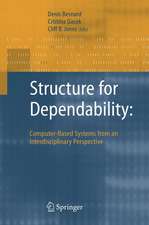Computer-Aided Design of User Interfaces VI
Editat de Victor Lopez Jaquero, Francisco Montero Simarro, Jose Pascual Molina Masso, Jean Vanderdonckten Limba Engleză Hardback – 7 apr 2009
| Toate formatele și edițiile | Preț | Express |
|---|---|---|
| Paperback (1) | 1273.74 lei 6-8 săpt. | |
| SPRINGER LONDON – 13 oct 2010 | 1273.74 lei 6-8 săpt. | |
| Hardback (1) | 1280.18 lei 6-8 săpt. | |
| SPRINGER LONDON – 7 apr 2009 | 1280.18 lei 6-8 săpt. |
Preț: 1280.18 lei
Preț vechi: 1600.23 lei
-20% Nou
Puncte Express: 1920
Preț estimativ în valută:
245.04€ • 266.26$ • 205.97£
245.04€ • 266.26$ • 205.97£
Carte tipărită la comandă
Livrare economică 21 aprilie-05 mai
Preluare comenzi: 021 569.72.76
Specificații
ISBN-13: 9781848822054
ISBN-10: 1848822057
Pagini: 340
Ilustrații: IX, 319 p. 139 illus.
Dimensiuni: 155 x 235 x 32 mm
Greutate: 0.65 kg
Ediția:2009
Editura: SPRINGER LONDON
Colecția Springer
Locul publicării:London, United Kingdom
ISBN-10: 1848822057
Pagini: 340
Ilustrații: IX, 319 p. 139 illus.
Dimensiuni: 155 x 235 x 32 mm
Greutate: 0.65 kg
Ediția:2009
Editura: SPRINGER LONDON
Colecția Springer
Locul publicării:London, United Kingdom
Public țintă
Professional/practitionerCuprins
The Challenges of User-Centred Design.- Model-Driven Engineering of Workflow User Interfaces.- User Interface Development Life Cycle for Business-Driven Enterprise Applications.- Using Profiles to Support Model Transformations in the Model-Driven Development of User Interfaces.- Translating Museum Visual Contents into Descriptions for Blind Users: A Multidisciplinary Approach.- A Location-Aware Guide Based on Active RFIDs in Multi-Device Environments.- Design of Adaptative Video Game Interfaces: A Practical Case of Use in Special Education.- A Preliminary Study of Two-Handed Manipulation for Spatial Input Tasks in a 3D Modeling Application.- Design of a Model of Human Interaction in Virtual Environments.- A Space Model for 3D User Interface Development.- Evaluation and Optimization of Word Disambiguation for Text-Entry Methods.- Integrating Usability Methods into Model-Based Software Development.- Supporting the Design of Mobile Artefacts for Paper-Based Activities.- Integrating Dialog Modeling and Domain Modeling: The Case of Diamodl and the Eclipse Modeling Framework.- Inspector: Interactive UI Specification Tool.- Creating Multi-platform User Interfaces with RenderXML.- Analysis Models for User Interface Development in Collaborative Systems.- CIAT, A Model-Based Tool for Designing Groupware User Interfaces Using CIAM.- Towards a Methodological Framework to Implement Model-Based Tools for Collaborative Environments.- Towards a Formal Task-Based Specification Framework for Collaborative Environments.- Task-Driven Composition of Web User Interfaces.- Collaborative Modelling of Tasks with CTT: Tools and a Study.- A Generic and Configurable Electronic Informer to Assist the Evaluation of Agent-Based Interactive Systems.- Quality of Adaptation: User Cognitive Models in Adaptation Quality Assessment.- Design by Example of Graphical User Interfaces Adapting to Available Screen Size.- A Method to Design Information Security Feedback Using Patterns and HCI-Security Criteria.- Domain-Specific Model for Designing Rich Internet Application User Interfaces.- Design Patterns for User Interface for Mobile Applications.- On the Reusability of User Interface Declarative Models.
Textul de pe ultima copertă
This book gathers the latest experience of experts, research teams and leadning organizations involved in computer-aided design of user interactive applications. This area investigates how it is desirable and possible to support, to facilitate and to speed up the requirements engineering life cycle of any interactive system:
requirements engineering, early-stage design, detailed design, development, deployment, evaluation and maintenance.
In particular, it stresses how the design activity could be better understood for different types of advanced interactive systems such as: context-aware systems, multimodal applications, multi-platform systems, pervasive computing, ubiquitous computing, and multi-device environments.
requirements engineering, early-stage design, detailed design, development, deployment, evaluation and maintenance.
In particular, it stresses how the design activity could be better understood for different types of advanced interactive systems such as: context-aware systems, multimodal applications, multi-platform systems, pervasive computing, ubiquitous computing, and multi-device environments.
Caracteristici
Includes supplementary material: sn.pub/extras






























